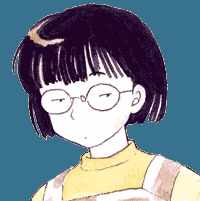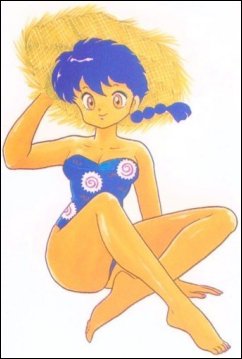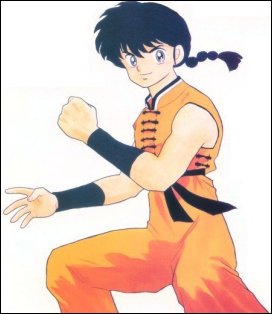

 Ranma 1/2 Memorial Interview
Ranma 1/2 Memorial Interview
Why did you think up the idea of a main character that transforms?
Takahashi: I thought, "If the main character is both male and female, I can draw lots of boys and girls." It's really fun for me to draw both boys and girls, and in terms of the drawings, it stays interesting.What made you settle on water as the agent of change?
Takahashi: I had a difficult time thinking up how I could make the change. I did consider a change whenever [Ranma] is punched. But then his face would be swollen... it's pitiful. [1] I was thinking- boy... girl... boy... girl. Then I thought of a noren (a noren is a hanging curtain at an entrance to a place of business that often doubles as a sign. It also often reads "man" on one side and "woman" on the other) at a public bath, and I just thought, "a bath- it's hot water and cold water." It's a silly creation, but I really am fond of it. It was my hope to make [Ranma 1/2] a production that would give you a laugh, make you happy or energize you. I think it was successful for some time. Fighting... love interests... gags... Japan, but in a Chinese style. I wanted to make Ranma a manga with no nationality.The name "Ranma" is an unusual one. What made you think of this?
Takahashi: I thought it would be a cute [name] for either a boy or a girl. [2]The idea of Jusenkyo cursed hot-springs was also a unique one, wasn't it?
Takahashi: At the time I decided water would be the agent of transformation for Ranma, the idea of a cursed spring soon came up. It was soon decided that China was the only place that would have such mysterious springs.From Nyannichuan to Maonichuan, various springs are introduced. Were you thinking of the various types of cursed hot springs from the beginning?
Takahashi: I was just thinking of a place that had a lot of cursed hot springs. So I hadn't decided on any types. In creating a new character, I also had to think about that character's ideal transformation. So, [the springs] just increased in unison with the characters. [laughs] I wonder just how many there are?Imagine you had fallen into such a cursed hot spring. What would you transform into?
Takahashi: I think something that could fly across the sky would be good. I even introduced characters, like Pantyhose Taro and other residents of Ho'osan, who had wings. I think it would really feel wonderful to fly freely across the sky like that.
Are there any characters whose personality came to differ from what you originally conceived?
Takahashi: The lead character Ranma. I originally intended for him to be a clean-cut, incredibly energetic kid who was into fighting. But, he became somewhat indecisive and picky. I think everyone has those kinds of sentiments. So I think my own feelings of that nature went right through my pen and were reflected in my drawings of Ranma. Originally, Ranma was a neater, tidier, and energetic young man. However, by the time I realized it, he became indecisive and stingy. Even so, I like the more normal Ranma too.Which character then is embued with the most emotion?
Takahashi: Ranma and Akane's personalities are a little more twisted than expected... Ryoga, who would show his emotion a bit more directly, was easy to draw. In contrast, it was difficult to understand stronger characters such as Shampoo and Kuno. After drawing Kuno two or three times, I thought, "I can't really follow him." [laughs] [3] However, in terms of creating the story, his was a convenient existence, lining up with Happosai. He was a beneficial character in that he would force the story to move, for instance causing trouble due to his feelings being too strong.You also introduced a lot of subcharacters: are there any that are your favorites?
Takahashi: I like the suspicious-looking Gambling King. Kind of Gag-like. Also, I like the Cursed Hot-Springs Guide; for some reason I really feel at ease when I draw him. Out of the animals, it's P-chan. I also like the Panda and Shampoo's cat, but if there were such a cute piglet [as P-chan], I would definitely want one as a pet for my home. [laughs] There are three essential elements to the series: Ranma, fighting, and romance. Which story was fun to draw? I like them all. I want to draw a manga you can laugh at and enjoy reading, so I tried to include a lot of gags in every episode. I really enjoy drawing something like a "running gag," where a character grows tired and just goes flying off. Since the serialization was long, it could have grown tiresome if it were just "fighting, fighting" or "romance, romance" so after a fighting sequence I might draw a brief gag episode, followed by a romantic story... in order to create the freshest Ranma, I did some rotation [of the stories].
Is there a love scene you are fond of?
Takahashi: I like the way Ryoga gets shy when talking to Akane... the atmosphere when he's uneasy and can't say what he wants to. When I write such an earnest scene, I feel shy myself, so I have to conclude with some kind of gag. That's something that's true about other scenes as well, not just love scenes. I might stick something gag-ish in a corner of the frame, or such. There's a feeling that it's okay, even if no one realizes.Which episode left the strongest impression?
Takahashi: That's the episode where Ranma learns the Hiryu Shoten-ha. Ranma is weakened by Happosai's moxabustion. Every character that had yet to defeat Ranma came together to take him down. And, in turn, a great many characters come to Ranma's defense. The subcharachers which had been introduced up to this point tended to gravitate toward and collide with this individual called Ranma. So, in this sense, I finally had a feeling for these characters starting to moblize. This story is really significant to me because it marks the emergence of a conclusion, where I had just been worrying and drawing.In terms of fighting, there's the battle with Herb. Probably because I was able to draw both male and female types for this character. I was also able to enjoy the obvious confusion of Herb's subordinates.

Which drawing did you spend the most time on, of those included in this volume?
Takahashi: Of course, that's the extra-large poster! [laughs] It's the first time I've drawn something so large! I tried to bring out a progression from spring to summer, fall to winter... it took a lot of effort to arrange all the characters with all the detail involved. It was also much harder than I thought to arrange the characters with respect to the seasons. Expecially for "winter." I hadn't really thought up anything but the martial arts figure skating couple. After some thought, I felt that winter is best represented by a kotatsu, [a kotatsu is generally a quilt or blanket used to keep the feet and legs warm in winter (often a small heater is placed in a recessed floorspace under the kotatsu blanket, as in beneath a small Japanese table.)] so I made a "zone of idleness" crowding into a kotatsu.
Out of illustrations for the current publication, which do you really like?
Takahashi: When I'm drawing I always think, "this is the best picture!" I like all the calendar illustrations, but I especially like the illustration of Ranma on page 66.In gathering all these illustrations, have you come to realize anything in particular?
Takahashi: A surprising number of the cover illustrations I drew for Sunday, a youth-oriented magazine, are similar in appearance. I do wonder if they bear this resembalance as a natural result of the poses... they are very energetic and look as though they might go flying off. I didn't realize this until all the illustrations had been consolidated.Actually, this is the first time an illustration book [for Ranma 1/2] is being made available. I'm really thrilled, because there isn't normally a way to see one's own illustrations arranged in such a manner.
Last, I have a word for the readers. Thanks for your longtime support and encouragement on Ranma. The 9 years of serialization [in Japan] are all due to your support. When I read your fan letters, I feel your enjoyment of my works and your personal encouragement. This has been a great source of motivation for me. From now on, I'll be drawing other fun works. Thank you for your continued suport!
Footnotes
- [1] In the short story Excuse Me For Being A Dog! Takahashi experiments with the concept of a protagonist that transforms via being punched in the face. This series was released in 1985, two years prior to Ranma 1/2.
- [2] Takahashi actually explains this in another interview. She states, "I had an unusually hard time with Ranma, but the phrase “kaitouranma wo tatsu” (快刀乱麻を断つ)(something similar to “tackling plenty of tasks diligently/to cut the Gordian knot”) came to mind, and it had a good ring to it, so I decided to go with that."
- [3] Takahashi has spoken about Kuno's uniqueness and how odd she found him and how she seemed not to know what he would do in a story.

らんま1/2メモリアル・ブック
|